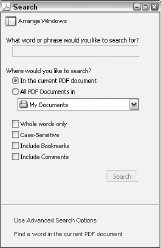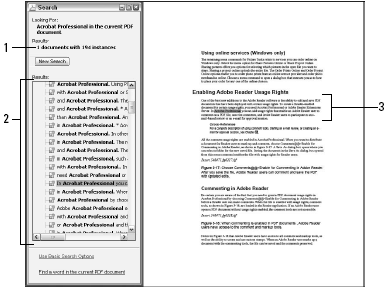Using Search Window
You perform searches by accessing a menu command, clicking the Search tool, or by using shortcut keys. To search from the menu, choose Edit >> Search, or open a context menu with the Hand tool, and select Search. Click the Search tool in the File toolbar and the Search window opens.

To use the keyboard shortcut, press Ctrl+Shift+F and likewise the Search window opens. These all allow you to search for a word in an open document, in a collection of PDF files stored on your hard drive, or any type of external media. When you invoke a search, the Search window opens as a floating window.
The window can be sized by dragging the lower-right corner out or in to size the width and height. When the Search window is in view, you type a word or words to be searched for in the field box that appears at the top of the window. You are limited to the actual word(s) you want to find when you perform a simple search.
You cannot use Boolean (AND, OR, and NOT) operators or any kind of search expressions if performing a simple search. The area where you type words and phrases to be searched is in the field box following the text “What word or phrase would you like to search for?” in the Search window.
Rather than describe this field box by name, the term “first field box” or “search field box” is used throughout this. When you see such a reference, realize it refers to the area where you type words and phrases to be searched.
If you type more than one word in the search field box, the results are reported for the exact phrase. For example, if you search for “Adobe Acrobat Professional,” all the occurrences of “Adobe Acrobat Professional” are reported in the results list. Individual occurrences of Adobe, Acrobat, and Professional are not reported.
In other words, you don’t need to place phrases within any quotes or special characters to find the results. In the Search PDF window, you choose where you want to search and the options to narrow the search from the list following the first field box. The following sections describe several choices that are available.
Where To Search
The question presented to you is “Where would you like to search?” Two radio buttons appear where you choose whether to search the current open file or search locally on your hard drive, a network server, or a media storage device attached to your computer such as removable media or CD-ROMs.
If you select the second radio button for “All PDF Documents in,” you can narrow the search to a directory, drive, or media device by opening the pull-down menu and choosing from the hierarchy of drives and folders appearing in the menu options. Acrobat also permits you to search through Bookmarks and Comments as the Find toolbar does.
Check boxes appear below the pull-down menu for these items. If Bookmarks and Comments are to be part of your search, check the respective item(s). After you choose the options you want, click the Search button. The results appear in the Search window.
The total number of found instances for your search are noted at the top of the window and hot links appear in the scrollable list for the words found in the documents according to the search options you selected. Click any text and the respective document page opens in the Document pane with the first occurrence of the searched word highlighted.
Navigating Search Results
Menu commands are also available for navigating through search results. Choose Edit >> Search Results to open a submenu where you find four menu commands used with searches. The Next Result and Previous Result items are discussed earlier. The other two items are as follows:
- Next Document (Ctrl+]): Click Next Document to bypass all found instances in the currently viewed file and open the next file listed in the Search results list.
- Previous Document (Ctrl+[): This command offers the opposite response as Next Document—it moves backward through previously viewed documents.
Next Result and Next Document are not available until you first invoke a search. Next Document becomes active only when a search result exists in two or more documents. Previous Result and Previous Document become active only after you have visited a result in a document more than once so as to retrace your steps backward to see previously viewed results.
If you search an open document and the search results are reported in the Search window, you’re better off clicking results in the window than using menu commands. When you select any menu command, the Search window disappears (on Windows) when viewing documents in Acrobat in a maximized view.
This is most annoying when you want to keep the Search window open. On the Mac you don’t have to worry about using menu commands or opening files. The Search window remains in view at all times until you close it.
Stopping a Search
When you start a new search, a button appears in the Search window so you can stop the search. Click Stop and the results found prior to stopping are listed in the scrollable list. If you click Stop, you need to search again starting at the beginning of the search to continue. Click the New Search button and the search starts over from the beginning of the file.
Displaying Results
The results list is neatly organized for you in the Search window. If you search the open document, the search results report found words beginning at the front of the document and list occurrences as they are found on following pages. If you search multiple documents, the occurrences are listed in groups according to the individual documents where the words are found.
The hierarchy is similar to that of Bookmarks. A plus symbol in Windows or a right-pointing arrow in Macintosh is shown for each document where results have been found. Click the icon, and the list expands the same way Bookmarks and comments expand.
The icon changes to a minus symbol in Windows or a down-pointing arrow in Macintosh when a list is expanded. Click the icon again to collapse the list. You can use Search or the Find toolbar to find words in the open document. Search offers more search criteria options and shows a list of results. As a general rule, using Search is much more efficient than using the Find toolbar.
Searching Files and Folders
If you search through a large collection of PDF files, Search works away loading up the results window. Clicking a link to open a page where results have been found won’t interrupt your search. You can browse files while results continue to be reported.
To search a hard disk, a media storage device, a network drive, or a folder in any of these locations, open the pull-down menu below “All PDF Documents in” and select a folder location. The moment you select a folder, the “All PDF Documents in” radio button is activated. The pull-down menu lists the drives and servers active on your system.
If you want to search a particular folder, select the item denoted as Browse for Location (Windows or Macintosh) at the bottom of the pulldown menu. The Browse For Folder (Windows) or Choose a folder to search (Macintosh) dialog box opens. Navigate your hard drive as you would when searching for files to open.
When you find the folder to be searched, click the folder name and click OK. When you click a file in the Results window, the Search window becomes hidden. If you want to show the Search window after clicking a file in the Results window, you can press Ctrl+Shift+F or use the Status bar (Windows) to open the window. On the Mac, the Search window remains open when you browse search results.
After you click OK in the Browse for Folder/Choose a Folder dialog box, the Search window returns. The search does not begin until you click the Search button. Before clicking Search, you can examine the name listed as the target folder. The selected folder is displayed in the Search window by folder name. If all looks as you expect, click Search.
